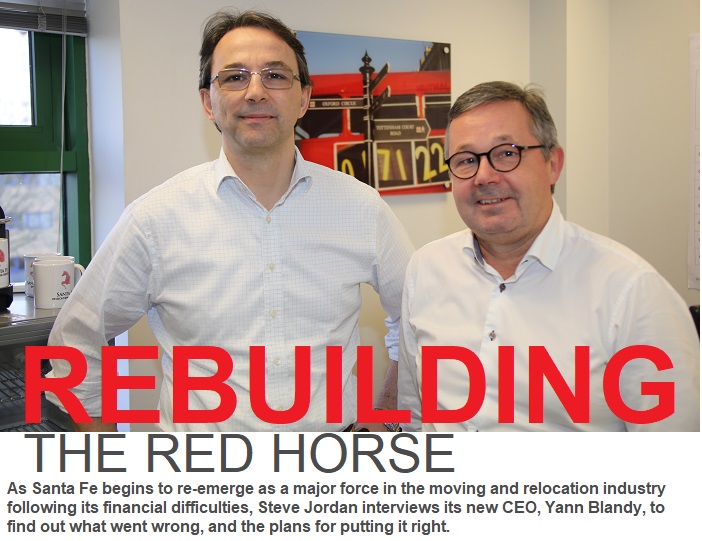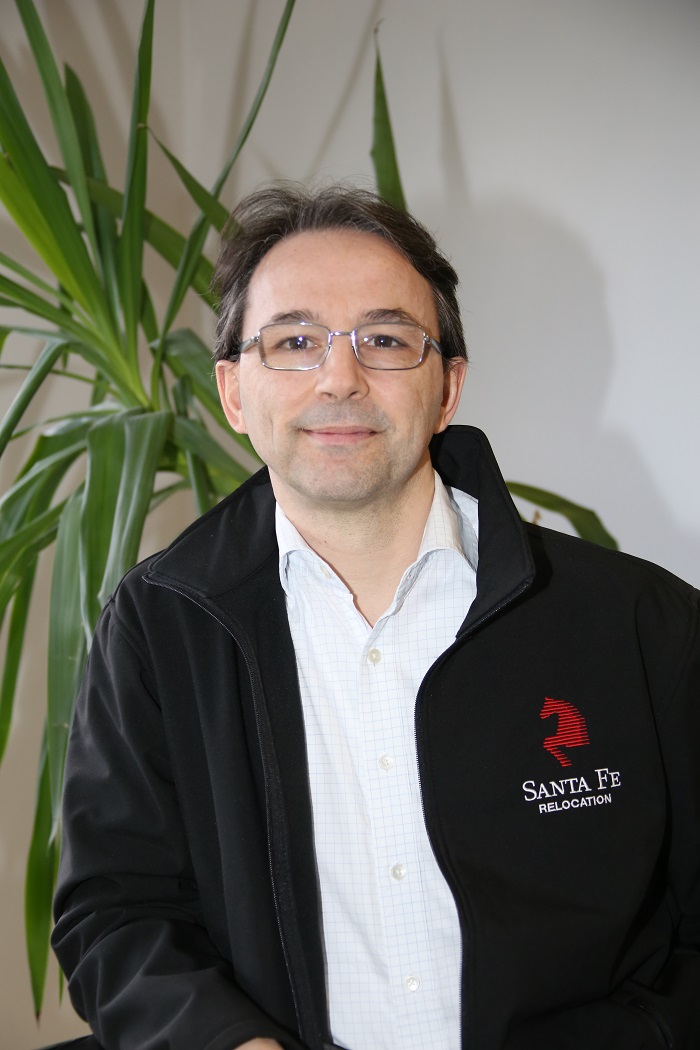As Santa Fe begins to re-emerge as a major force in the moving and relocation industry following its financial difficulties, Steve Jordan interviews its new CEO, Yann Blandy, to find out what went wrong, and the plans for putting it right.

It’s no great secret that Santa Fe has been in a precarious financial position for some years. But from 25 September, 2019, the company has been in new ownership. I was interested to find out how the approach was now going to be different, what lessons had been learned, and what the industry can expect from one of its most prominent players.
Yann Blandy is the new CEO of Santa Fe. He’s 49 years old, French, and has spent the last 25 years or so living in Sweden. He is thoughtful, measured and precise in his responses. He thinks carefully about every question I ask. Sometimes he pauses and makes a few notes before answering. His background in HR and his experience over the last 12-14 years handling turn-around cases makes him, he believes, ideally placed to pick up his new challenge. “I guess that Santa Fe is at the intersection of HR and turnaround,” he said.
In long-term
Santa Fe’s new owner, appropriately called Lazarus, is not, according to Yann, a traditional private equity company. “We take over companies caught in what we call ‘special situations’, some would say distressed assets,” he explained. “We don't have a time horizon. We do evergreen investments which means we could be here as long as it takes and at a minimum 12-18 months to get the company back in shape.”
I wondered how the company could be rebuilt so quickly. “This is not a project; it’s an investment, we are here to make good returns, and it happens to be at the crossroads of something that I am passionate about, which is HR,” he said. “I already have calls lined up with agents and partners to re-establish the connection, to understand what went wrong and what we can do differently to make it right. We are also working on improving our account management capabilities to ensure higher client retention across the board. You have to start the conversation and then make sure there is a culture in place to do something about it.”
 Why Santa Fe?
Why Santa Fe?
While working with Santa Fe last year, as a consultant, Yann realised that the company had two hidden assets. “Number one is its people,” he said, of which Santa Fe employs around 1800 worldwide. “It's amazing how dedicated those people are and how complicated we have made their lives. It's interesting to see how they fight every day to deliver fantastic service for our customers in spite of the complexities we have introduced. I now want to make things much easier for them.”
The second hidden asset, Yann said, is the installed customer base. “But we haven't been good enough to retain them, understand their needs or cross-sell our services. We have thousands of customers but very few of them buy the whole suite of services we offer.” He said that when he identified those hidden assets, and that 80% of the problems were self made, the acquisition of the business became an attractive proposition.
Mistakes of the past
I asked where, in Yann’s opinion, Santa Fe had gone wrong in the past. “As a leader you have to be respectful of the past, realistic about the present and optimistic about the future,” he said. “Looking back there have been some misconceptions about what this business is all about. The first was that we were moving containers; this is not what we do. We take care of people's lives and give them the best possible experience. We also underestimated the value of relationships with our customers, agents and partners. Just being silent with our agents and partners, for example if you're unable to pay bills, is unacceptable. We made mistakes. Close relationships were bruised because of our willingness to cut costs and we removed a whole lot of individuals who were extremely valuable in building those relationships. That took us in a negative spiral.”
Expansion and the USA
Santa Fe currently has around 80 offices in 40 countries or so. Does Yann have any strategic plans to expand further? “In the past the business has tried to be everything to everyone, everywhere,” he said. “This is the absence of a strategy. We need to be clear about who our customers are, where we can serve them, where we can win, where we should invest and where we should step back. If we are not geared to be in certain places, we shouldn't be there. That’s why we have agents and partners. For example, our previous US strategy was wrong. We went into the US believing we would be top dog: five years down the road, we were nobody. We announced huge ambitions and then backed off: relationships were ruined.”
Yann explained that Santa Fe’s future US activity would be purely for the facilitation of business from Asia and Europe, business that would be handled by local US agents; and as a platform to sell to the consumer market, again with the operational side handled by US partners. “We will not be attacking the US corporate market,” said Yann. “Our aim is to be good in fewer places, not average everywhere. We can't be everything to everyone.”
Focus on quality
At the front end of any business strategy it the product. For Santa Fe, it’s the quality of the services performed by its front-line staff. I wondered how, with such a large organisation, Yann planned to maintain service at the highest level. He paused again, and made careful notes before answering. “It's a good question. Essentially, it's in the DNA of all our frontline staff. That’s how they were trained. That's why it’s so important to retain talented people.”
He said that, at a Group level, the company will continue to be committed to quality. “When we took over the company people thought we were going to take it down market, reduce prices and become a low-cost competitor. That rumour was wrong. We are committed to quality and to maintaining our FAIM quality standard in the top tier of suppliers.”
Changing markets
Santa Fe is, essentially, a corporate moving and relocation company. 80% of it’s revenue comes from corporate accounts. But although there is no plan to change that, Yann acknowledges that the market has changed. Today, the company needs to have a much more direct route to market to catch the lump sum customers that represent an increasing proportion of it. With that in mind, the company is making a radical change. “We are creating a separate consumer business,” Yann explained. “I don’t think we've capitalised on that side of the market enough but by the end of this year we will have a new, separate, consumer-only business.” He added that it will still be called Santa Fe, but with a slightly different branding.
Of course, technology will play a major part in that transformation and Yann acknowledged that the company wasn’t currently using all the available technologies and that there is some catching up required. “My challenge to the team is to not look at what's best practice in the industry, but to look at what is best practice in e-commerce in terms of the customer journey; we then apply that to the moving business, not the other way around.” He said that he would be using ‘best of breed’ solutions rather than building a bespoke system. “We will be investing at least twice as much this year in our digital strategy than we did last year.”
The chances of success
I asked Yann how he rated his chances of turning the business around considering the rather precarious starting point. He said that the company was not in a mess because of what the market was doing, but because of what it was doing. “The good news is that means it's fixable,” he said, “and that's what we're putting our energies into.” A key factor was the re-financing of the debt which had been on a very harsh repayment deadline that would have been impossible to meet. “We are now a normally indebted company with a financing deadline that is far off in the future. This is a big uncertainty that has been removed.”
He said that this had been done to reassure staff, customers and partners. “But we don't have a magic wand and a number of things have to change for this business to be successful. We need to engage with staff and customers, invest in high-growth areas and increase efficiency. So we have defined a number of clear focus areas and I see our success increasing every day that we continue to stick to the plan. We have to balance the necessary investments with the necessary efficiencies to make sure that we are much more profitable in the future.” That said, there is a long lead time between making a decision and it taking effect, so he’s had to manage expectations. He accepts that it might get worse before it gets better. “Just because we are called Lazarus, doesn't mean that we can do miracles!”
The message
My final question to Yann was simple: what is your message to The Mover’s readers? He paused again, this time for a full minute, before answering. “I want to say to your readers that I believe the direction that we're taking, with the culture that we are changing, will lead Santa Fe to be a much more reliable partner. We are trying to put this business back on the map as an organisation that is approachable, someone you can talk to. We are re-introducing a challenger mentality rather than trying to dominate everything. We have taken some flack, but we are getting back in shape.”
Yann is keen to make himself available to staff, customers and partners, and he will be attending the FIDI conference in Osaka in April. He doesn’t underestimate the task of reviving Santa Fe, but he is confident about the future. “Sorry to disappoint some of our competitors, but we are going to stick around,” he said. “I wouldn't discount Santa Fe anymore.”
Photo (top): Yann Blandy (left) and Deputy CEO Runar Nilsen.